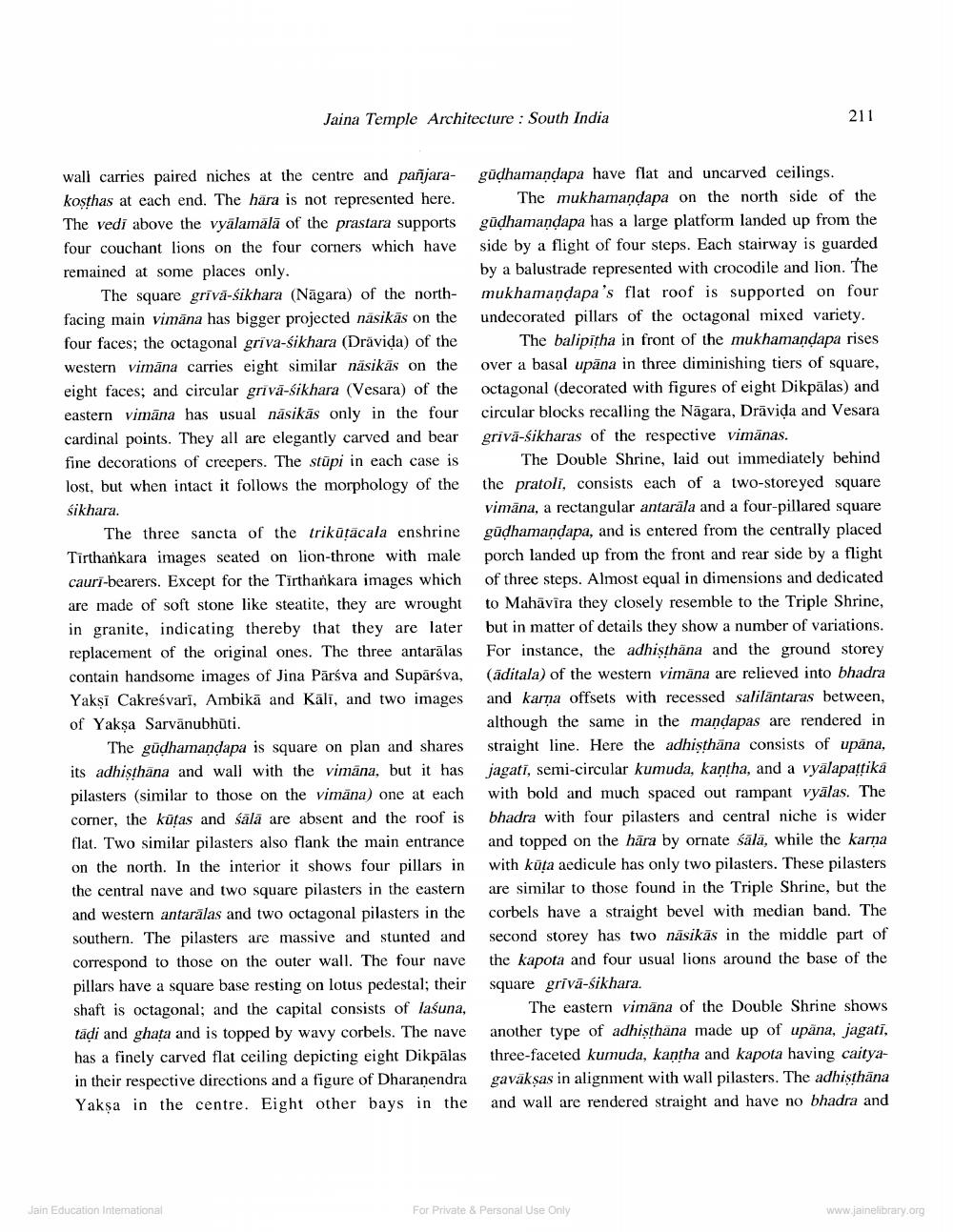________________
Jaina Temple Architecture : South India
211
wall carries paired niches at the centre and panjara- kosthas at each end. The hara is not represented here. The vedi above the vyālamālā of the prastara supports four couchant lions on the four corners which have remained at some places only.
The square grīvā-śikhara (Nāgara) of the north- facing main vimāna has bigger projected násikās on the four faces; the octagonal grīva-śikhara (Dravida) of the western vimāna carries eight similar näsikäs on the eight faces; and circular grīvā-śikhara (Vesara) of the eastern vimāna has usual nāsikās only in the four cardinal points. They all are elegantly carved and bear fine decorations of creepers. The stūpi in each case is lost, but when intact it follows the morphology of the śikhara.
The three sancta of the trikütäcala enshrine Tirthankara images seated on lion-throne with male caurī-bearers. Except for the Tirthankara images which are made of soft stone like steatite, they are wrought in granite, indicating thereby that they are later replacement of the original ones. The three antarālas contain handsome images of Jina Pārśva and Supārsva, Yakşi Cakreśvari, Ambikā and Kāli, and two images of Yakşa Sarvānubhūti.
The güdhamandapa is square on plan and shares its adhisthana and wall with the vimana, but it has pilasters (similar to those on the vimāna) one at each corner, the kütas and śālā are absent and the roof is flat. Two similar pilasters also flank the main entrance on the north. In the interior it shows four pillars in the central nave and two square pilasters in the eastern and western antaralas and two octagonal pilasters in the southern. The pilasters are massive and stunted and correspond to those on the outer wall. The four nave pillars have a square base resting on lotus pedestal; their shaft is octagonal; and the capital consists of lasuna, tādi and ghata and is topped by wavy corbels. The nave has a finely carved flat ceiling depicting eight Dikpālas in their respective directions and a figure of Dharanendra Yaksa in the centre. Eight other bays in the
gūdhamandapa have flat and uncarved ceilings.
The mukhamandapa on the north side of the gūdhamandapa has a large platform landed up from the side by a flight of four steps. Each stairway is guarded by a balustrade represented with crocodile and lion. The mukhamandapa's flat roof is supported on four undecorated pillars of the octagonal mixed variety.
The balipītha in front of the mukhamandapa rises over a basal upāna in three diminishing tiers of square, octagonal (decorated with figures of eight Dikpälas) and circular blocks recalling the Nāgara, Drāvida and Vesara grivā-śikharas of the respective vimānas.
The Double Shrine, laid out immediately behind the pratoli, consists each of a two-storeyed square vimāna, a rectangular antarala and a four-pillared square gūdhamandapa, and is entered from the centrally placed porch landed up from the front and rear side by a flight of three steps. Almost equal in dimensions and dedicated to Mahāvīra they closely resemble to the Triple Shrine, but in matter of details they show a number of variations. For instance, the adhisthana and the ground storey (āditala) of the western vimāna are relieved into bhadra and karna offsets with recessed saliläntaras between, although the same in the mandapas are rendered in straight line. Here the adhisthāna consists of upăna, jagati, semi-circular kumuda, kantha, and a vyalapattika with bold and much spaced out rampant vyālas. The bhadra with four pilasters and central niche is wider and topped on the hāra by ornate sala, while the karna with kūta aedicule has only two pilasters. These pilasters are similar to those found in the Triple Shrine, but the corbels have a straight bevel with median band. The second storey has two nāsikās in the middle part of the kapota and four usual lions around the base of the square grivä-sikhara.
The eastern vimāna of the Double Shrine shows another type of adhisthana made up of upana, jagati, three-faceted kumuda, kantha and kapota having caityagavākşas in alignment with wall pilasters. The adhisthāna and wall are rendered straight and have no bhadra and
Jain Education Intemational
For Private & Personal Use Only
For Private & Personal Use Only
www.jainelibrary.org




